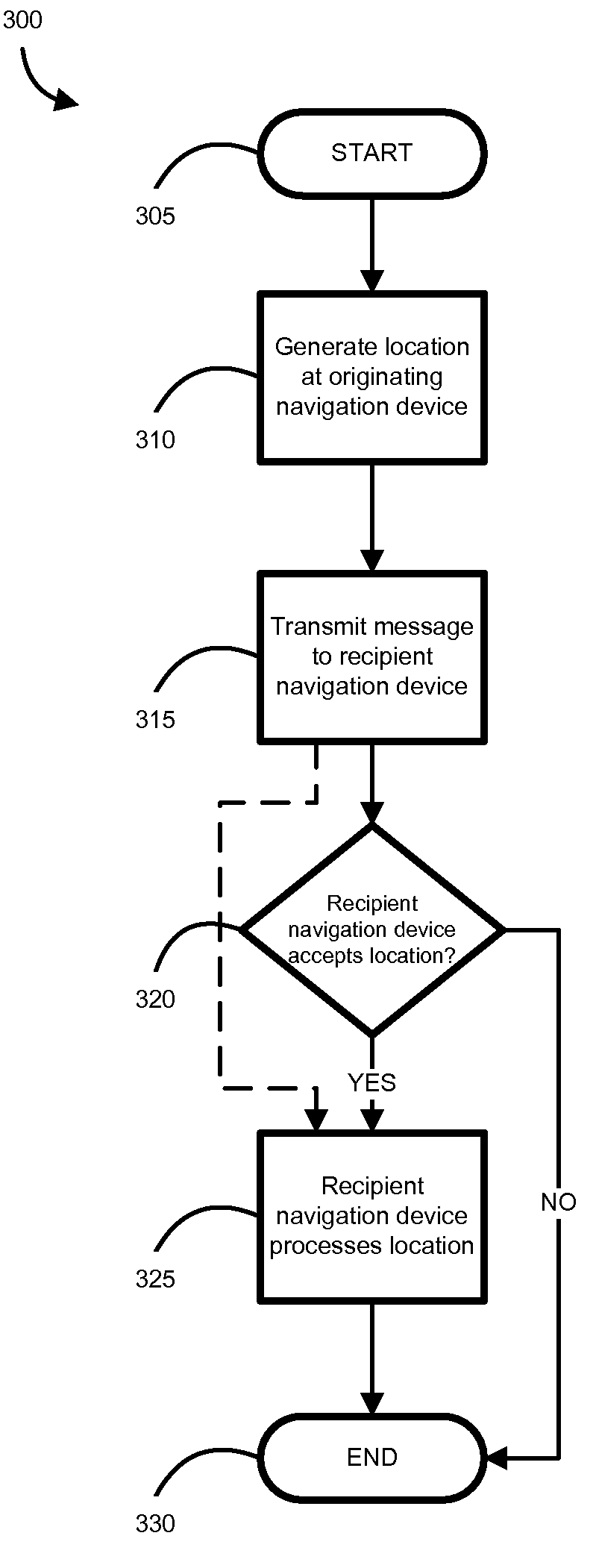[0011]Another embodiment includes a method for processing an alert location at a navigation device. The method comprises receiving the alert location which is generated from an alert condition and a location, displaying a map, and adding the alert location to the map. The method may also associate additional data with the alert location. In addition, the method may present a suggested alert condition based on the received alert location. Further, the method may selectively process the alert location. A filtering rule may be used to selectively prevent further processing of the alert location. The method may generate a route from a current location of the navigation device to the alert location, and the current location may be determined using global positioning system. In addition, the method may determine a planned route from a current location of the navigation device to a user-defined location. An estimated travel time along the planned route may be determined. Further, the estimated travel time to the user-defined location may be adjusted by an estimated delay caused by the alert condition occurring at the alert location. The estimated delay could be determined by monitoring a change in position of a second navigation device, which is also the source of the alert location. An alternative route to the user-defined location may be determined such that the alternative route avoids the alert location.
[0012]Another embodiment includes a navigation device for processing an alert location. The navigation device comprises means for receiving the alert location which is generated from an alert condition and a location, means for displaying a map, and means for adding the alert location to the map. The navigation device may also include means for associating additional data with the alert location. In addition, the navigation device may also include means for presenting a suggested alert condition based on the alert location. Further, the navigation device may include means for selectively processing the alert location. In addition, the navigation device may include means for applying a filtering rule against the alert location to selectively prevent further processing of the alert location. The navigation device may include means for generating a route from a current location of the navigation device to the alert location, and the current location may be determined using global positioning system. In addition, the navigation device may include means for determining a planned route from a current location of the navigation device to a user-defined location. An estimated travel time along the planned route may be determined. Further, the estimated travel time to the user-defined location may be adjusted by an estimated delay caused by the alert condition occurring at the alert location. The estimated delay could be determined by means for monitoring a change in position of a second navigation device, which is the source of the alert location. The navigation device may include means for determining an alternative route to the user-defined location such that the alternative route avoids the alert location.
[0013]Another embodiment includes a computer program product which comprises a computer-readable medium. The computer-readable medium comprises instructions for receiving an alert location which is generated from an alert condition and a location, displaying a map, and adding the alert location to the map. The computer-readable medium may also include instructions for associating additional data with the alert location. In addition, the computer-readable medium may include instructions for presenting a suggested alert condition based on the received alert location. Further, the computer-readable medium may include instructions for selectively processing the alert location. In addition, the computer-readable medium may include instructions for applying a filtering rule against the alert location to selectively prevent further processing of the alert location. The computer-readable medium may include instructions for generating a route from a current location of a navigation device to the alert location, and the current location may be determined using global positioning system. In addition, the computer-readable medium may include instructions for determining a planned route from a current location of the navigation device to a user-defined location. An estimated travel time along the planned route may be determined. Further, the estimated travel time to the user-defined location may be adjusted by an estimated delay caused by the alert condition occurring at the alert location. The estimated delay could be determined by instructions for monitoring a change in position of a second navigation device, which is the source of the alert location. The computer-readable medium may further include instructions for determining an alternative route to the user-defined location such that the alternative route avoids the alert location.
[0014]Another embodiment includes a server which comprises a connection, and a processor which is operable to receive an alert location from a first navigation device and is operable to transmit the alert location to at least one second navigation device. The alert location is generated from an alert condition and a location generated by the first navigation device. The processor may multicast the alert location to a plurality of second navigation devices using the connection. Further, the processor may selectively prevent the connection from transmitting the alert location to the at least one second navigation devices by processing a filtering rule. The filtering rule may be inputted into the server using an interface. The processor may generate a suggested alert condition based on the received alert location. In addition, the connection may transmit the suggested alert condition to the at least one second navigation device.
 Login to View More
Login to View More  Login to View More
Login to View More 


